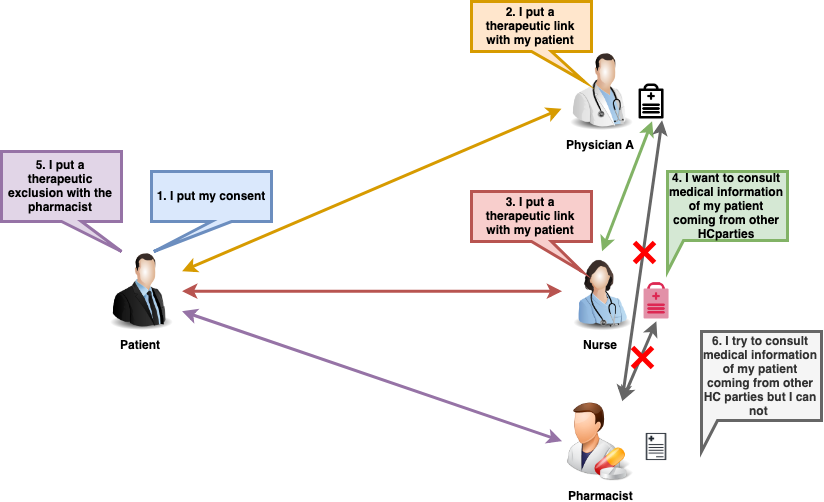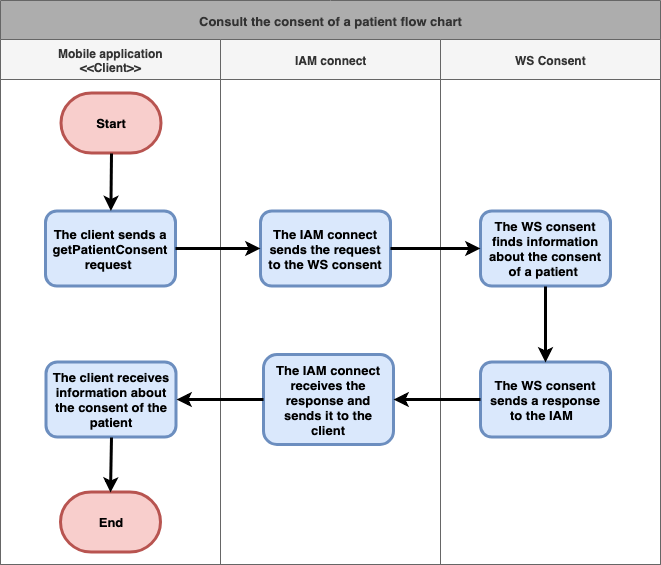| Table of Contents |
|---|
Used documentation
| Cookbook/ materials | Version | Location | ||||||||
|---|---|---|---|---|---|---|---|---|---|---|
| eHealthConsent WS Cookbook | 1.9 | |||||||||
| Jira ticket MHEH-12 | - |
| Jira ticket MHEH-13 | - |
| Jira | ||||||
|---|---|---|---|---|---|---|
|
| Jira | ||||||
|---|---|---|---|---|---|---|
|
| Jira | ||||||
|---|---|---|---|---|---|---|
|
| Jira | ||||||
|---|---|---|---|---|---|---|
|
| Jira | ||||||
|---|---|---|---|---|---|---|
|
| Jira | ||||||
|---|---|---|---|---|---|---|
|
General information
In the figure below, we present a logical view about the relation relationship between the three basic services of the ehealth platform that are the WS Consent, the Therapeutic link WS, and the Therapeutic exclusion services.
The following end users can declare or revoke a patient consent via the WS Consent :
...
A consent can be managed by different types of end-users:
- Health Care (HC) parties: a physician, a pharmacy (it is noteworthy that there is no difference between pharmacy and a pharmacist), Hospital, Dentist, Nurse, Midwife
...
- Management by Patient : Patient, Mandatary or Parent
...
- , Health Insurance Organization (HIO), Authorized organization in behalf of a HIO, Group of nurses
- Citizen: a patient, a parent of a patient, a mandatary
A consent may have two types. Indeed, it is called prospective when it is valuable for data posterior to the signing date (i.e. the date that should be taken into account is the ‘medical date’ of the transaction). It is referred to as retrospective in the opposite case.
The Consent service provides four methods (it is noteworthy that in this use case only the GetPatientConsent method is used):
- The "PutPatientConsent" method allows an end-user to declare the patient consent (i.e. make a consent active)
- The "RevokePatientConsent" method enables an end-user to revoke the patient consent (i.e. make a consent inactive)
- The "GetPatientConsent" method allows an end-user to consult information about a consent and to check whether its status (i.e. active or inactive)
- The "GetPatientConsentStatus" method is similar as the "GetPatientConsent" method with the status of the consent returned in the response message.
Basic flow
| Flow | Specification | ||||||||||||||||||
|---|---|---|---|---|---|---|---|---|---|---|---|---|---|---|---|---|---|---|---|
Use case ID | ATH-UC-12-BF | ||||||||||||||||||
Use case name | Consult the consent of a patient using the GetPatientConsent method | ||||||||||||||||||
Actors |
| ||||||||||||||||||
Short Description | In order to change a profile, the user should do a global logout and should authenticate him/herself a second timeconsult the consent of a patient using the SOA-based version, it is important to use the Token exchange service in order to convert a JWT token into a SAML one (and vice versa). The aim of this use case is to check a consent status after its activation or revoke. | ||||||||||||||||||
| Priority | 1 (High) Must have: The system must implement this goal/ assumption to be accepted. | ||||||||||||||||||
Pre-Conditions |
| ||||||||||||||||||
Post-Conditions |
| ||||||||||||||||||
Steps (basic flow) | 0 | The user has an open session in the IDP with the old profile | 1 | The user | do a global logout in order to close the session in the IDP2 | The user re-authenticates him/herself via the mobile application in order to change the profile | 3 | The mobile application sends an openID connect authorizationtries to consult the consent and the client sends a getPatientConsent request to the IAM connect4 | |||||||||||
| 2 | The IAM | connects redirectsconnect routes the | messagerequest to the | eHealth IDP in a browser5 | The IDP detects that there is not an open session with the NISS and the name of the user | 6 | The IDP redirects the request to the CSAM in order to open a session | 7 | The user selects the authentication way (i.e. itsme, eID, TOTP) | 8 | The user is authenticated and CSAM returns a SAML assertion to the IDP regarding the user | 9 | The user selects a new profile and the IDP returns the selected profile to the IAM connect | 10 | The IAM connect creates an access token JWT with the new profile and returns it to the clent | 11 | The user is authenticated and accesses to the permitted services in the mobile application with respect to the new profile | WS consent | |
3 | The WS consent finds information about the consent of a patient | ||||||||||||||||||
| 4 | The WS consent sends a response to the IAM | ||||||||||||||||||
5 | The IAM connect receives the response and sends it to the client | ||||||||||||||||||
| 6 | The client receives information about the consent of the patient | ||||||||||||||||||
Exceptions (exception flows) |
| Exceptions (exception flows)||||||||||||||||||
Frequency |
| ||||||||||||||||||

